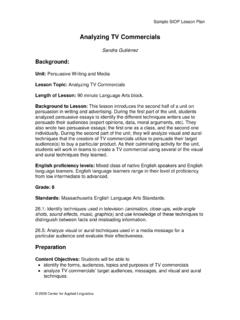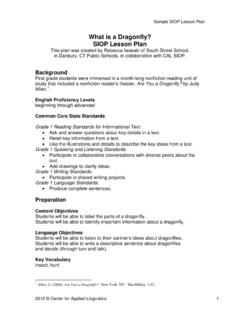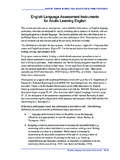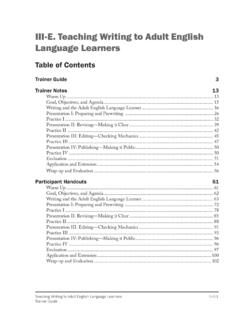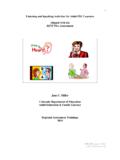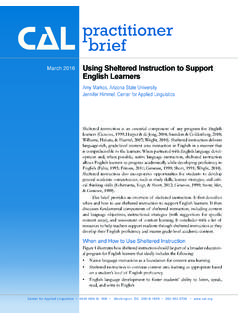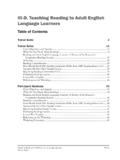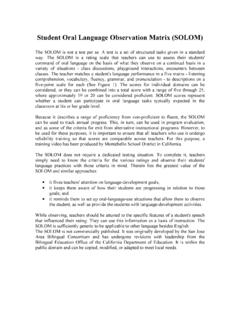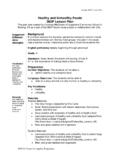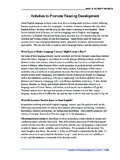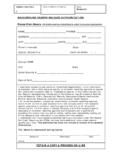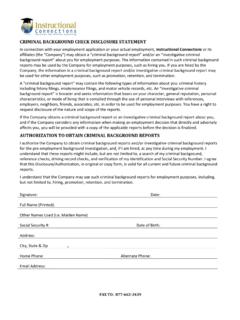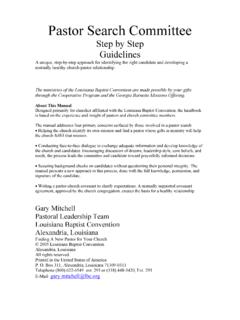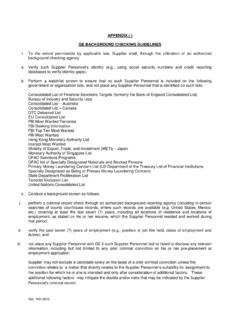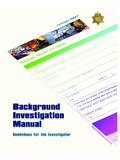Transcription of Lesson Plan for Building Background: The English Settle ...
1 Sample SIOP Lesson plan 2002 by the Center for Applied Linguistics This Lesson plan was created under the auspices of the Center for Research on Education, Diversity & Excellence. Educators may print copies without permission for their personal use or to share with colleagues. For other uses, permission must be requested in writing from the Center for Applied Linguistics. For more information on CAL's SIOP work, visit Lesson plan for Building background : The English Settle America Robin Liten-Tejada Gunston Middle School, Arlington, VA background The class is beginning Chapter 5 in America s Story, The English Settle America, in which students learn the various reasons for settling different colonies, and the leaders and groups of people involved.
2 English proficiency level: Advanced beginners Grades: 6 Standards: Virginia Standards of Learning. ) The factors that led to the founding of the colonies including escape from religious persecution, economic opportunity, release from prison, and military adventure. Preparation Content Objectives: Students will identify different reasons why people immigrate to this country today and compare them with the reasons of the early English settlers. Students will locate colonies and cities on a map. Language Objectives: Students will discuss topics in small groups; make predictions; classify people and places; and skim text for information. Materials: newsprint, colored dot stickers, transparency of world map & timeline (from prior Lesson ), transparency and handout of map of 13 colonies with Jamestown and Providence identified, sentence strips with names of people and places, large laminated maps, America s Story (Bernstein, 2001) Motivation Arrange students in small groups of three or four and have them list on newsprint at least five reasons why people today immigrate to the , thinking of their family and people they know.
3 When they are finished (7 10 minutes), list their ideas on the board on butcher paper or newsprint, with groups reporting one idea at a time. Instruct students to cross off ideas on their lists when they are reported by any classmate. Sample SIOP Lesson plan 2002 by the Center for Applied Linguistics This Lesson plan was created under the auspices of the Center for Research on Education, Diversity & Excellence. Educators may print copies without permission for their personal use or to share with colleagues. For other uses, permission must be requested in writing from the Center for Applied Linguistics. For more information on CAL's SIOP work, visit Have students review class lists and make their own predictions about the most common reason why families in the class immigrated.
4 Review the definition of common that most students learned in math class, as in greatest common factor and least common multiple, using word cards. In journals, have them complete the sentence, I predict the most common reason why our families came is _____. Provide each student with a colored dot sticker. Tell them to come to the board in their groups and put their sticker next to the main reason why their family came. This provides a colorful representation of the class reasons, allows students to move, and provides a visual way to check predictions. Discuss results. Retain this chart for later in the unit to check to see if these common reasons match the most common reasons for the early settlers.
5 Presentation Explain to students that people have always immigrated here for a variety of reasons. We have been studying the first European settlers, and it will be interesting to compare their reasons for settling with reasons today, to see if they are the same or different. On the newsprint next to the class list of reasons, make another column called Early European Settlers and elicit from students the reasons studied so far for the Spanish and Pilgrims to come to America ( , claim land, search for gold, bring Catholic religion, have freedom of religion). Record what students remember. Explain that now the class is going to study reasons why other groups of English people came, who they were, and where they went.
6 Show them the transparency of the map and timeline developed for the last chapter in the textbook that shows where the Spanish and English claimed land in the Americas. Color in more of the timeline and say, Now we are going to study this time period, and learn more about the places we colored. Practice Have students open their books for a chapter preview. Discuss the meaning of the title The English Settle America, and have students look at the pictures and bolded words for clues as to what might be other reasons why English people came. Then have students close the book to classify a list of people and places in the chapter, using their background knowledge or language deduction skills.
7 Sample SIOP Lesson plan 2002 by the Center for Applied Linguistics This Lesson plan was created under the auspices of the Center for Research on Education, Diversity & Excellence. Educators may print copies without permission for their personal use or to share with colleagues. For other uses, permission must be requested in writing from the Center for Applied Linguistics. For more information on CAL's SIOP work, visit On the board, create two column headings: People and Places. Show students sentence strips with the names of people and places that are listed in the book. Read aloud, one at a time, and have students simultaneously vote whether they think it is person or place.
8 Tell students to raise one hand for people and two hands for places. Give one student the strip to place on the board in the proper column. Ask the students to justify their choices. Then have the students copy the vocabulary classification in their journals. Review Explain: Now we know what places we will be studying about. Do you know where these places are? Give each student a blank map of the 13 colonies and one large laminated map per group, and have students use it to locate the places listed on the board. Then review the maps together, and have students use crayons or markers to color in the places they will be studying about. Homework Give students a graphic organizer chart for the chapter.
9 Ask them to skim the chapter to match the people on the class list with the place they started their journey and complete the organizer.
